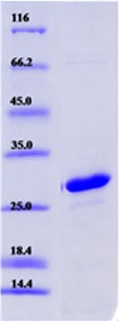Aequorea victoria Green fluorescent protein /enhanced GFP GFPSparkTM (His Tag)
GFP
- 100ug (NPP2808) Please inquiry
| Catalog Number | P69001-S08E |
|---|---|
| Organism Species | Aequorea victoria |
| Host | E. coli |
| Synonyms | GFP |
| Molecular Weight | The recombinant Aequorea victoria GFPSparkTM consisting of 245 amino acids and has a calculated molecular mass of 27.7 kDa. |
| predicted N | Met |
| SDS-PAGE |  |
| Purity | > 97 % as determined by SDS-PAGE |
| Protein Construction | A DNA sequence encoding the Aequorea victoria GFP (AAB65663) (Met1-Leu238, except for the point mutations of intellectual property :F64L, S65T, R80K, S99F, T153M, I167V, H231L) was expressed, with a polyhistide tag at the C-terminus (Patent 201410599023.9). |
| Bio-activity | GFPSparkTM expression vector transfected 293H cells transiently. After 48h, the strong green fluorescent signals can be detected under the excitation channel of 455~495 nm. |
| Research Area | |
| Formulation | Lyophilized from sterile PBS, pH 7.5 1. Normally 5 % - 8 % trehalose and mannitol are added as protectants before lyophilization. Specific concentrations are included in the hardcopy of COA. |
| Background | The green fluorescent protein (GFP) is a protein that exhibit bright green fluorescence when exposed to blue light. GFPSparkTM is an improved variant of the green fluorescent protein GFP. It possesses bright green fluorescence (excitation/ emission max = 487 / 508 nm) that is visible earlier than fluorescence of other green fluorescent proteins. GFPSparkTM is mainly intended for applications where fast appearance of bright fluorescence is crucial. Its amazing ability to generate a highly visible, efficiently emitting internal fluorophore is both intrinsically fascinating and tremendously valuable. It is specially recommended for cell and organelle labeling and tracking the promoter activity. |
| Reference |
